Every morning is a fresh start, but is the air fresh and clean too?
Keypoints:
- Morning air often has higher pollution levels than the afternoon due to atmospheric and local pollution factors.
- Data shows poor air quality in the mornings in Jabodetabek, Bandung, and Yogyakarta, especially near schools, markets, and beaches.
- Causes include the planetary boundary layer trapping pollutants and local sources like waste burning and traffic.
- To stay safe, check air quality, wear a mask, and use alerts to avoid high pollution times.
There's nothing more exciting than starting your activities when the sun rises in the east, especially for 'morning people'. Almost all activities are held in the morning, such as going to school, sunbathing the baby, doing groceries at the market, and jogging or exercising. The air is fresh and still quiet from the hustle and bustle of traffic, making the morning vibe often related to its 'better' air quality than other times of the day.
A survey conducted by Bicara Udara and Katadata Insight Center in 2021 showed that many people believe the air quality is best in the morning.
But, does the morning air really have better and healthier quality?
Well, sadly, no. Let's uncover the facts based on data! 👀
Below is a map of the distribution of Breath sensors in Jakarta taken on July 25, 2023, in the morning (08:30). The map is packed with red sensors, which means the air is 'Unhealthy'. Some locations are even purple, indicating that the air is 'Very Unhealthy'.
Now let's find out how 'healthy' the average morning air in Jabodetabek is this month. Check out the chart below!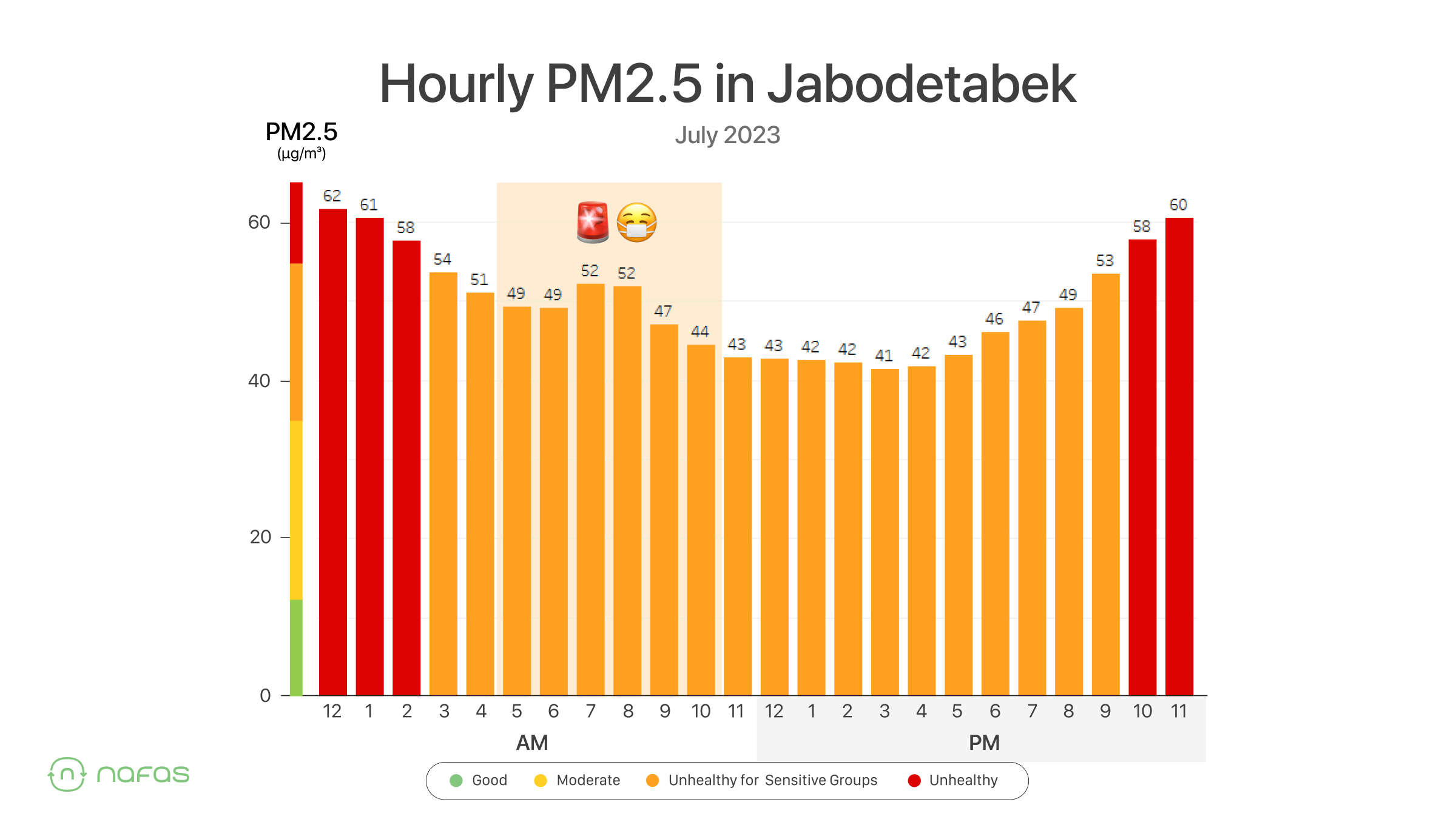
From the graph above, it can be seen that morning is not the best air quality time in Jabodetabek. In reality, morning pollution (6 AM to 10 AM) tends to be higher than afternoon pollution (11 AM to 4 PM).
Not only in Jabodetabek but also in Bandung and Yogyakarta, the morning air quality can be bad
Not only in Jabodetabek, similar conditions also occur in Bandung and Yogyakarta 😷 Let's see the following data!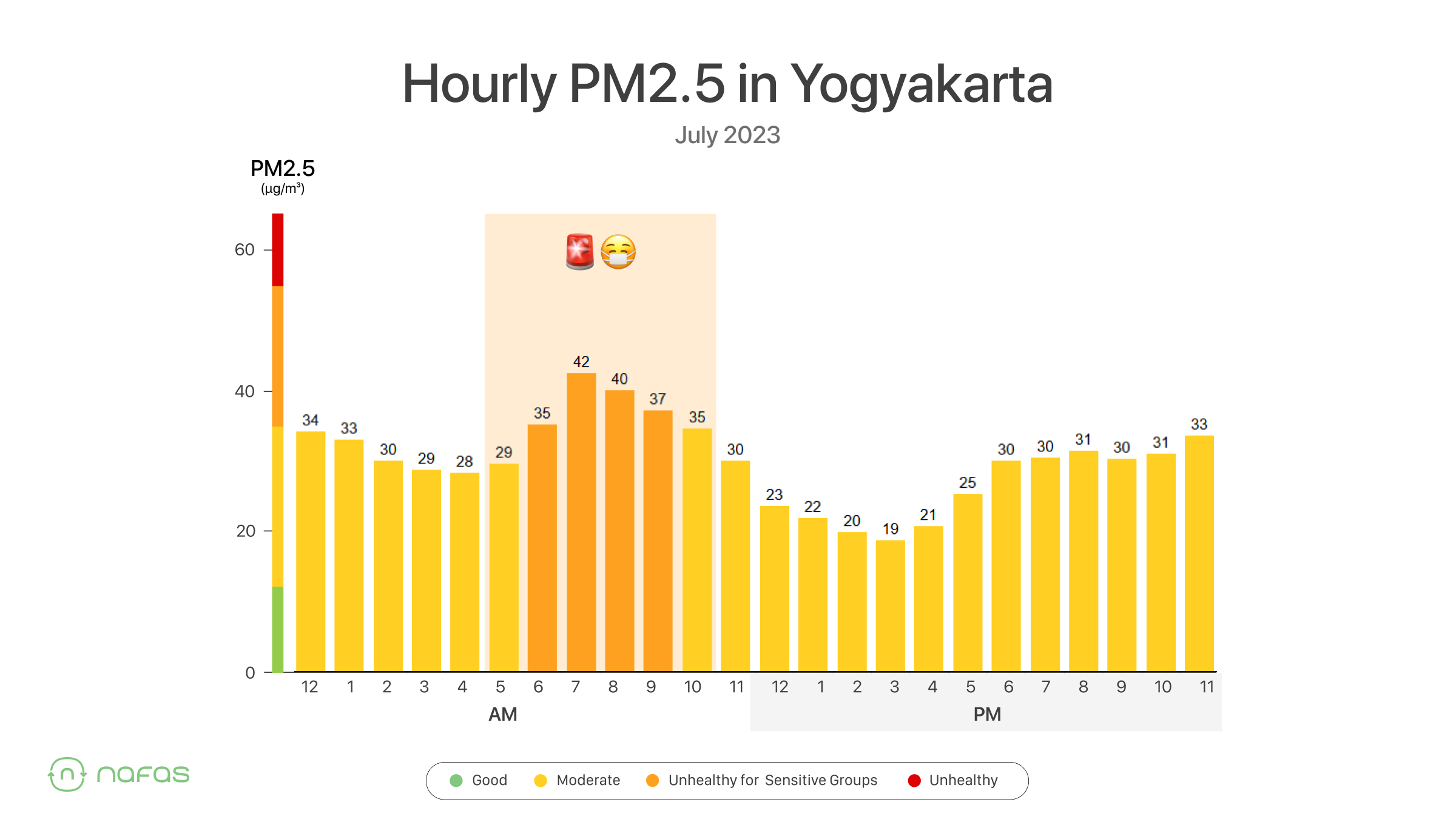

From the figure above, it can be seen that the peak of the highest air pollution occurs in the morning, between 6 AM and 10 AM. The air quality starts to get better in the afternoon, as it does in Jabodetabek.
——————————
Next, the Nafas team will show air quality data in places where people spend most of their time in the morning: Schools, Markets, and Beaches.
📚 I'm interested in what's going on in schools and colleges; how is the air quality?
"Morning is the time to go to school!"
Nafas also installed sensors in some locations where schools or campuses are located: Hang Tuah in Jakarta, Lebak Siliwangi in Bandung, and Gadjah Mada University in Yogyakarta. Let's see the quality of the area together!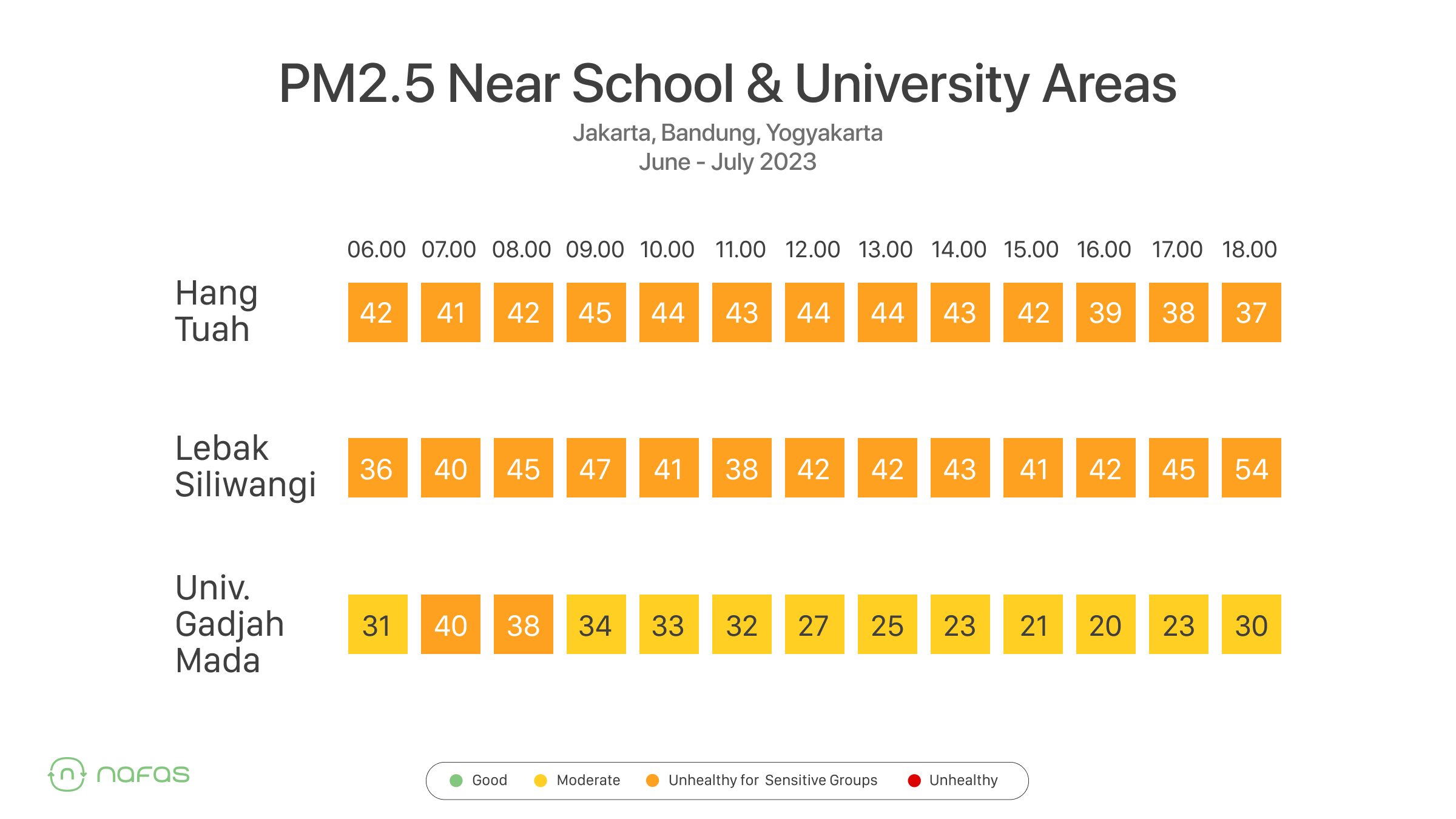
The data above show that pollution levels are quite high in the morning when children go to school (Hang Tuah, Jakarta) or college (Unpad, ITB Bandung, and UGM Yogyakarta). The air quality is even classified as 'Unhealthy for Sensitive Groups'.
🥑 What about the air quality in the market?
"Let’s go to the market early in the morning so you don't run out of goods!"
Now, let's see the data on air quality in the markets!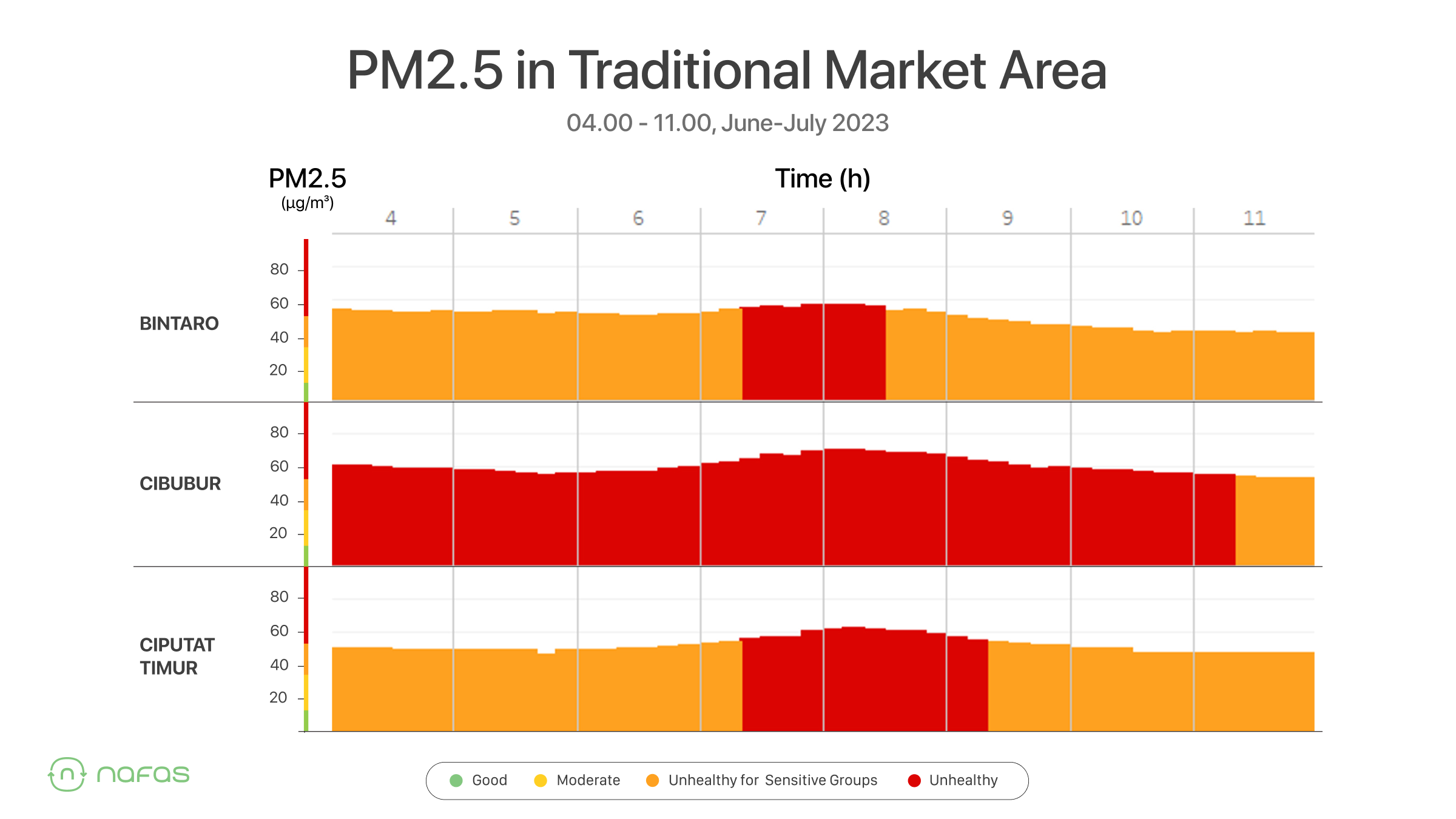
We advise you to always remember to put on a mask when doing your morning market shopping. The sensor data collected over the last two months from a location not far from the market indicates high pollution levels in the morning and early afternoon. You can clearly see that the morning is not a time with clean and healthy air by observing the poor morning air quality in Bintaro, Cibubur, and East Ciputat. This occurs as a result of the market areas' heavy traffic, which raises the area's PM2.5 pollution levels. Every time you leave the house, make sure to check the air quality and wear a mask.
🏖️ Does the morning air quality in areas near the beach also get as dirty as the previous two places?
"A morning stroll on the beach would be such a nice idea! It's cool, fresh, and the air is clean."
Now, let's take a closer look at the air quality at the beach in the morning!
According to the data, weekend mornings are also not the best time to relax or go for a walk on the beach 😔 Close to the beach, the areas of Ancol, Gelora, Pantai Indah Kapuk, and SCBD tend to have 'unhealthy' air, both for sensitive groups and the general population. As the air quality has improved, it may be possible to walk around the beach from 3 PM to 6 PM.
——————————
"What exactly leads to bad air quality in the morning?" might be the question on your mind after studying the data above.
Let's break down the reasons why!
Planetary boundary layers and hyperlocal pollution sources, the drivers of poor morning air quality
In general, high air pollution in the morning is triggered by two factors: the planetary boundary layer and the presence of pollution sources in the area. Here is the explanation.
Planetary Boundary Layer
Our atmosphere has a layer called the Planetary Boundary Layer. We live inside this boundary layer at the lowest altitude. If you're on an airplane, you can see the top edge of this layer from a certain altitude. Usually, this layer can be seen during morning to afternoon flights, which is characterized by the clear color of the sky above the layer.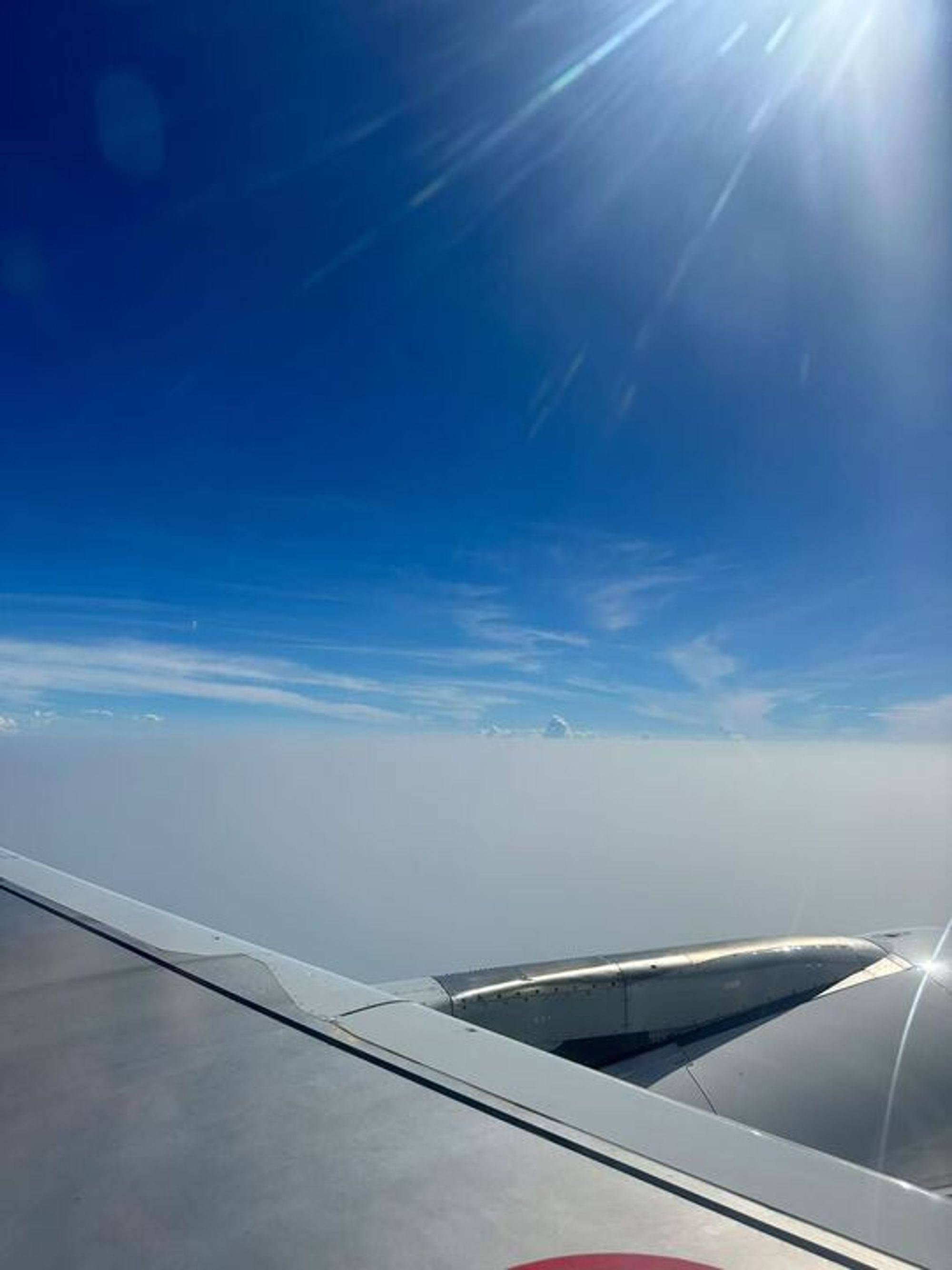
What's unique about this planetary boundary layer is that it moves up and down over time, depending on the temperature difference in the atmosphere. This planetary boundary layer is common in the atmosphere and usually occurs when the air above the Earth's surface is cold at night. The presence of this layer makes the space for PM2.5 to move more limited and makes PM2.5 pollution accumulate higher near the surface. These conditions usually begin to end during the day, resulting in improved air quality during the day.
Hyperlocal pollution sources
The second cause is the presence of hyperlocal pollution sources that occurred the previous day or night, which is also influenced by local wind patterns and weather.
Many Indonesians have 'normalized' waste burning as the quickest way to remove waste from sight. In fact, this activity is illegal and emits harmful pollutants into the atmosphere. Not only that, but local sources of pollution exist in the environment in a variety of forms, from the traveling of heavy trucks or cars to the existing industries (small or large) in the area.
So, is it better to stay at home and not go out in the morning?
Absolutely not! Poor air quality is not a reason to avoid going outside at all. The key is to "stay updated about air quality in your neighborhood." Nafas has a notification feature that lets you know when it's safe to go outside as the air quality is good.
✅ Follow the preventive tips below so you can stay safe outdoors:
1. Check air quality regularly on the Nafas app.
2. Wear a mask when leaving the house, recommended type of respirator such as N95.
3. Activate the alert feature on the Nafas app to receive notifications when pollution levels are high early in the morning or at certain hours of the day.